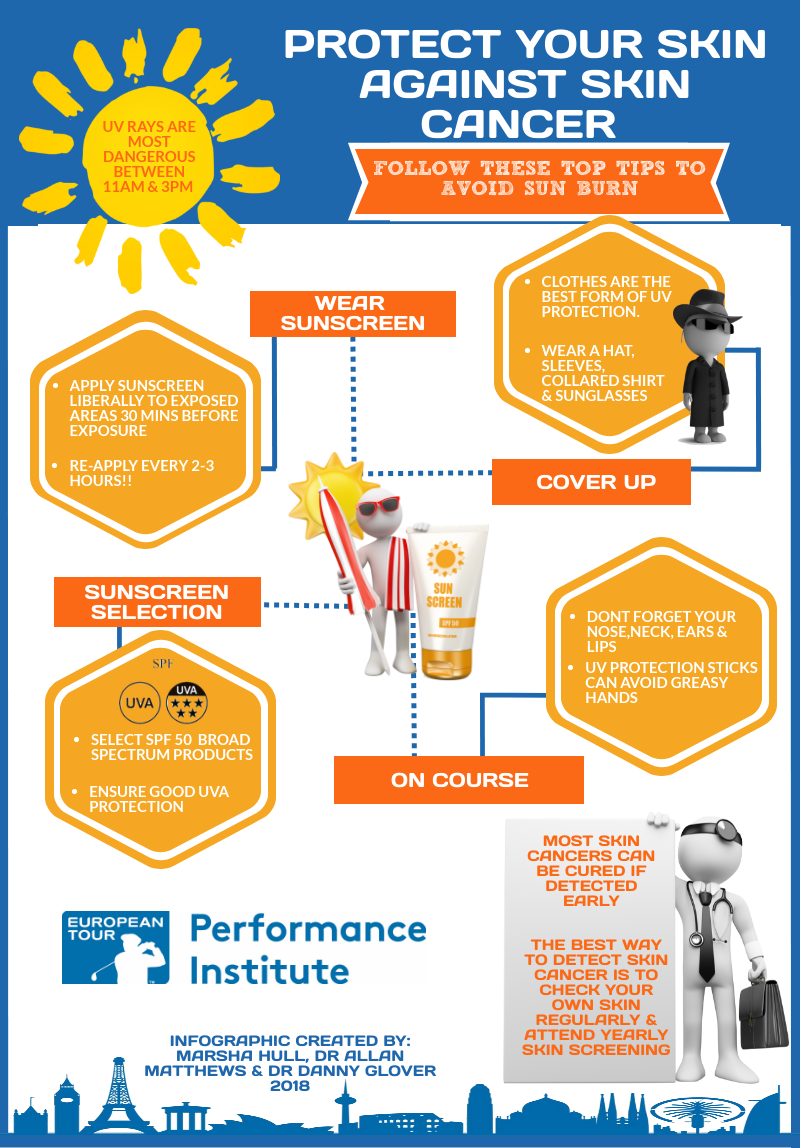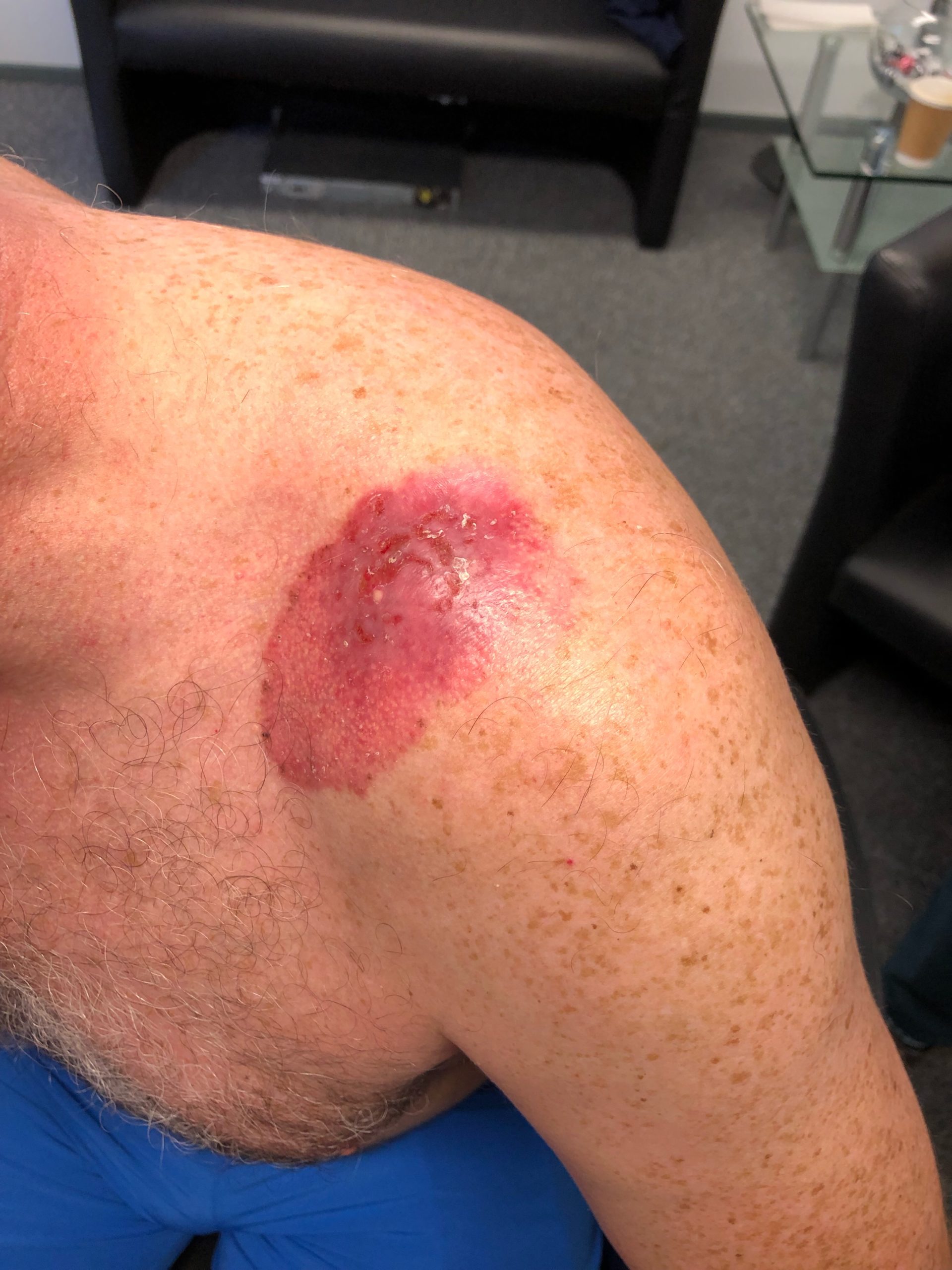The PGA European Tour Skin Cancer Screening and Education Service
Exposure to ultraviolet radiation (UVR) is the most important environmental risk factor in the development of cutaneous melanoma and non-melanoma skin cancers (basal cell carcinoma (BCC) and squamous cell carcinoma (SCC)), rates of which have been steadily increasing worldwide over the last 40 years.1 UVR can also cause painful sunburn reactions, skin pigment changes, accelerated skin ageing and eye disorders such as cataracts. Conversely, UVR has important health benefits. Exposure to ultraviolet-B (UVB) radiation stimulates vitamin-D production, which is essential for skeletal health and optimal immune function.2 There is emerging evidence that UVR has beneficial effects on cardiovascular risk factors independently of Vitamin D.3 Sunlight is also known to have mood-lifting effects.4
Overall, playing golf is associated with longevity, and both physical and mental health benefits.5 However, the golfing population face an increased risk of UVR associated skin problems, most importantly skin cancer. Studies to date indicate that golfers are definitely exposed to potentially harmful levels of UVR during play and outdoor practice, though the morbidity/mortality related to this exposure has never been quantified.6
Why is skin cancer screening important for professional golfers?
In view of their high level of occupational UVR exposure, professional golfers, caddies and golf industry workers are likely to benefit from skin cancer screening. The most common forms of skin cancer are preventable, and if detected early most skin cancers can be cured. Therefore, whilst a skin cancer screening consultation involves full skin examination using dermoscopy (examination of the skin using surface microscopy), the contact is also an opportunity to raise awareness of skin cancer and educate service users on the importance of UV protection and regular self examination and to highlight red flags to look out for in terms of identifying a possible skin cancer.

The European Tour Skin Cancer Screening and Education Service – the process.
The team consists of two consultant Dermatologists and an operations manager. Golfers, caddies and European Tour staff are informed of our presence at events either electronically or via signposting in the Tournament office and encouraged to book an appointment. A consultation lasts approximately 20 minutes and involves a general discussion about skin cancer including risk factors, common types and how these present, and how to be safer in the sunshine in the ‘workplace’. The individual is then offered a full skin examination with dermoscopy looking for any potentially worrying skin lesions. Discussion can then focus on self examination and sun protection measures, tailored to each individual. At the end of the consultation they are offered written educational materials, both general and golf specific and sunscreen samples depending on availability.
If an abnormal skin lesion is identified which requires further assessment, the service user is advised to see a dermatologist either via their own GP or privately. The recommended timeliness of this is dependent on the lesion in question and also the individual’s schedule. They are given a letter to produce their chosen medical provider documenting our findings, on which is our email address(s) for queries and feedback. Feedback on the final outcome is strongly encouraged for records. Occasionally an email dialogue will ensue, to track progress following onward referral. Sometimes skin lesions are identified which would benefit from a period of monitoring in the first instance, and which don’t necessarily require onward referral. In such circumstances the lesion will be photographed on the individual’s own smart phone and arrangements made for them to attend at a specific event in the future for review.
The story so far…
Since screening commenced in the 2018 season, 347 screening consultations have been carried out across 10 events. The average age of those screened is 40-years old (21 – 66), with 85% being male. The mix of service users has been 45% golfers, 30 % caddies and 25% others (European Tour staff or golfer’s/caddies families or team). 6% of screened individuals reported a previous history of skin cancer and 8% a history of pre-malignant skin disease i.e. actinic keratosis or lentigo maligna/melanoma-in-situ.
In terms of abnormal skin findings, 41 individuals have been identified with a single or multiple actinic keratoses. 8 probable BCCs have been detected, 3 of which have been confirmed. No SCCs have been noted. However, 21 atypical pigmented lesions have been flagged – 2 of these have been confirmed to be malignant melanoma; 2 lentigo maligna (melanoma in situ) and 2 dysplastic melanonaevi (atypical moles). A total of 31 service users have sought advice about a general skin problem including seborhhoeic dermatitis, acne, eczema, vitiligo, psoriasis and pityriasis versicolor.

A 44 y/o caddie with a large BCC on the left shoulder requiring extensive surgery. Lesion was treated as “dermatitis” for several year and casued significant discomfort when carrying golf bag.
Conclusion
The European Tour Skin Cancer Screening and Education Service is an important adjunct to the sports medicine service provided by the European Tour. It is clearly valued by the players, caddies and tour staff as a whole, judging by the fact that it is usually oversubscribed and roll-out to more events has been requested. Most importantly, certain individuals have benefited hugely from the service by having their skin cancer detected earlier than would have otherwise been the case.
Areas for future growth/development include:
- moving to a user friendly, electronic consultation proforma
- creating more golf-orientated educational materials
- driving increased availability of suitable sunscreen on tour e.g. by linking up with an official sunscreen provider for the Tour
- working with skin cancer charities to raise awareness of skin cancer and the importance of sun protection and self examination for recreational golfers
- having skin cancer screening and education hubs for spectators at golf events – this would need to be done in conjunction with a skin charity
- rolling out a similar programme of work in other professional outdoor sports such as cycling, athletics and ball sports
Authors & Affiliations
Dr Allan Matthews1,2 Dr Susannah Fraser 1,2
1 European Tour Dermatology Team
2 Department Of Dermatology, Queen Margaret Hospital, Dunfermline, Fife
References
- Lucas R, McMichael T, Smith W, Armstrong B. Solar ultraviolet radiation: global burden of disease from ultraviolet radiation. Environ Burden of Disease Series 2006; 13:205
- Theodoratou E, Tzoulaki I, Zgaga L, Ioannidis JP. Vitamin D and multiple health outcomes: umbrella review of systematic reviews and meta-analyses of observational studies and randomised trials. BMJ 2014; 348:g2035
- Weller RB. Sunlight has cardiovascular benefits independently of vitamin D. Blood Purif 2016; 41:130–134.
- Mead MN. Benefits of Sunlight: A Bright Spot for Human Health. Environ Health Perspect 2008; 116:A160–A167.
- Murray A, Daines L, D et al. The relationships between golf and health: a scoping review. Br J Sports Med 2017; 51:12–19.
- Matthews AG, Preston H, Murray A, Hawkes R. Golf and Skin Health: A Narrative Review. Exercise Medicine 2018; 2:13 | https://doi.org/10.26644/em.2018.013